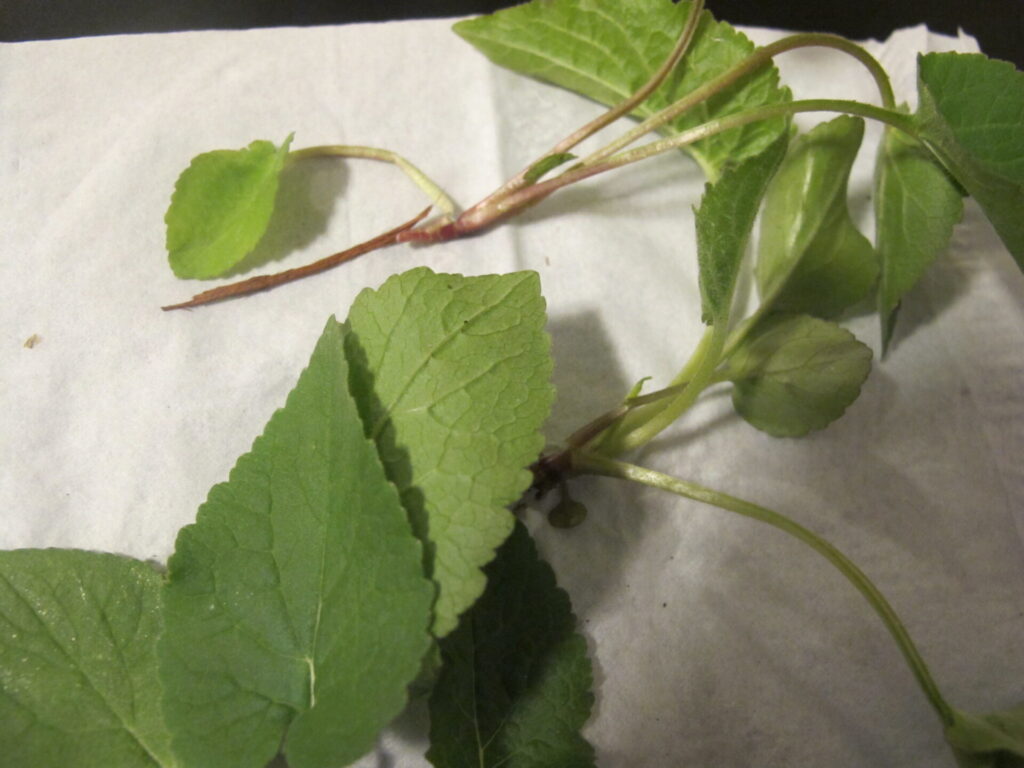
We have an ongoing extensive problem with this weed in my son’s garden. 3 years of hand weeding, much mulch and finally Roundup. Nothing has worked. Some of it is in shade and some in sun. The garden is in Stouffville. Black plastic cover could be applied in some areas? Identification and ideas for control would be wonderful.
Thank you for contacting the Toronto Master Gardeners on this weed. We think the weed in the photo could be creeping bellflower (Campanula rapunculoides). If it is, this would explain why you can’t eliminate the weed, it not only spreads by very aggressive underground rhizomes but produces tons of seeds. Even if a little bit of the rhizome remains in the ground it will form above ground shoots.
The issue of “how to rid your yard of weeds”, is a question we get asked a lot. Below are some suggestions on how to rid your yard of the creeping bellflower from a previous post we have published on noxious weeds.
You can try using either black tarp or clear plastic film; both will work, as they aim to kill weeds using different means. Black is used where the intent is to starve the weeds to death by preventing them from photosynthesizing, while clear plastic is used where you want to “cook” the weeds to death. Please take a look at the following answer for further information on both processes:
“Covering the ground with thick black plastic is an effective way to kill weeds. At first the weeds will begin to grow rapidly due to the heat under the black plastic however over time they will die from lack of food. Essentially, the weeds will starve since they cannot produce food through photosynthesis and eventually will exhaust their food supply and starve. This method takes time and will only work as long as no light reaches the plant.
Another effective non-chemical technique to eradicate weeds is through solarization. According to the University of California Integrated Pest Management:
“The method involves heating the soil by covering it with clear plastic for four to six weeks during a hot period of the year and when the soil will receive the most direct sunlight. Plastic tarps allow the sun’s radiant energy to be trapped in soil, heating the top 12 to 18 inches to temperatures lethal to a wide range of soilborne pests; including weeds, plant pathogens, nematodes, and insects. When properly done, the top layers of soil will heat up to as high as 140°F, depending on the geographic location. Soil moisture is important in this process, as wet soil conducts heat better than dry soil. Moisture also makes soil pests, weakened by the heat, more vulnerable to attack by beneficial soil microorganisms during and after treatment.”
In addition, solarization stimulates the release of nutrients from organic matter present in the the soil. It is especially effective for treating garden soils, where the intent is to plant vegetables, herbs, and flowers.”
While weeds are a nuisance, they do keep bare soil covered and reduce erosion. Consider what you will plant once the current weed is removed. Consider planting a ground cover or a pollinator garden. Choosing ground cover that spreads quickly and grows well in your garden should take over as soil protector. Ground cover with a dense growth pattern should suppress weeds the best. As noted in a previous published response to weeds, native plants might be a great alternative for your son’s garden.
The “Grow Me Instead” booklet, with link below, is specific to Southern Ontario. It discusses invasive ground covers, English Ivy, Goutweed and Periwinkle, which should be avoided. Alternatives such as Wild Strawberry, Wild Ginger, Wintergreen, Mayapple, Running Euonymus, Foamflower, Wild Geranium Bunchberry and Bearberry are much better choices, although some of these may be too tall for your requirements. There are also photographs beside each writeup which show any flowers that the ground cover may produce.
The booklet along with groundcovers, wildflowers and grasses also has suggestions for trees, shrubs, vines and aquatics that are native and hardy to this region.
Happy gardening.

